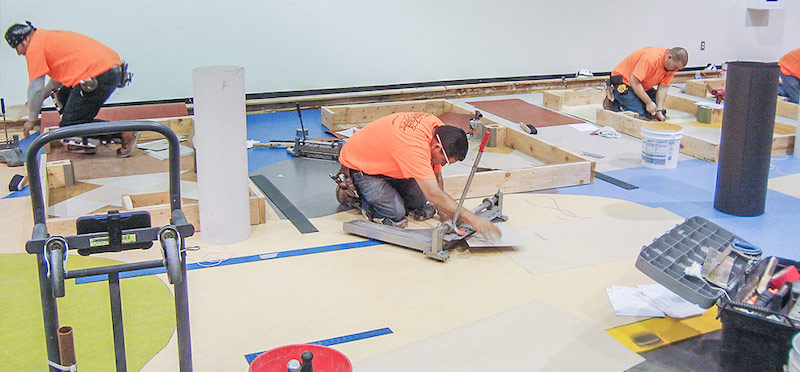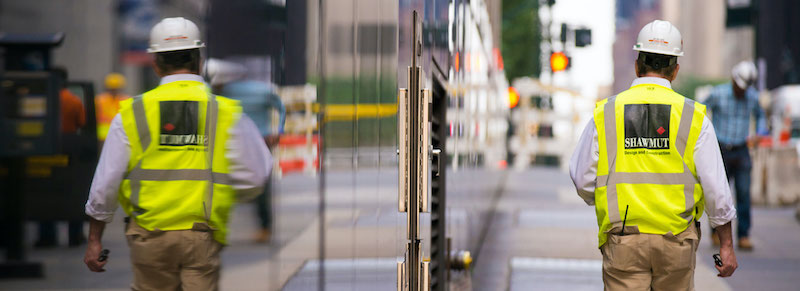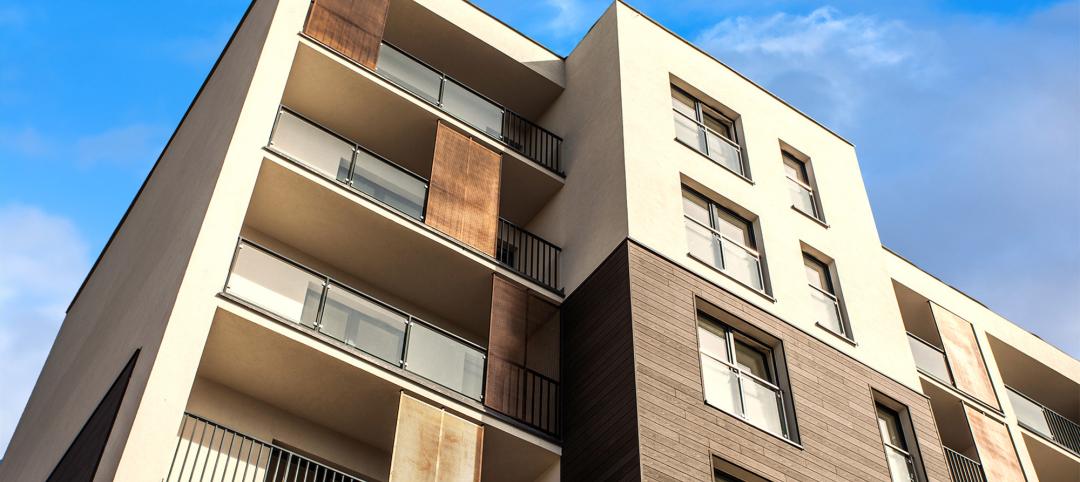As states start reopening their economies, and building reactivates, construction firms are giving more serious thought to how they can provide a safer environment for their employees and subs.
Boston-based Shawmut Design and Construction, in collaboration with trade unions, industry peer groups, and other firms, has rolled out a COVID-19 safety plan for its project sites across the country.
“The coronavirus has very quickly required a drastic change to the world, and specifically, to our construction industry,” says Les Hiscoe, Shawmut’s CEO. “Through technology partnerships, pilot programs, and grassroots innovation by our project team members in the field, we have created efficient, enhanced safety guidelines. Protecting our employees and everyone on our jobsites is our top priority, so we are engaging in real-time, adapting to our new environment’s requirements almost instantly, and never missing a beat.”
SHAWMUT MAXIMIZES TECHNOLOGY PLATFORMS
The plan includes safety protocols, new jobsite innovation, and COVID-19 risk assessment and response. Shawmut has developed a new custom technology platform that’s designed to check for COVID-19 symptoms and to manage contact tracing.
Called Shawmut Vitals, the platform allows employees and subs to self-certify daily health screenings by scanning a job-specific QR code, and then filling out a health survey. Employees who are symptomatic or have been exposed to someone who’s infected or at-risk will be flagged for further care or action.
Team members can access information on their mobile devices.
Also See: Nonresidential construction spending declines in March as pandemic halts projects
Shawmut has also mobilized platforms and technologies like SmartVid.io and Feevr to monitor safety compliance, enforce social distancing, and screen personnel for fevers.
The firm’s plan outlines stringent guidelines for self-awareness and reporting. A dedicated COVID-19 officer will be on site 100% of the time to enforce protocols, which include limiting any worker gatherings to no more than five people. Crews might be minimized and work shifts staggered.
Health screening guidelines, self-reporting, and all best practices will be reviewed regularly and reinforced with on-site signage, written in English and Spanish and located in high-traffic areas. Shawmut will ensure that an adequate amount of hand-washing stations will be available throughout all sites, with each unit at least six feet apart. For tasks that require more than one person for completion, additional PPE will be required.
JOBSITE INFECTION CONTROL REQUIRES EDUCATION AND TRAINING

Following infection-control guidelines has been central to the safety and health of flooring installation professionals. Image: International Standards and Training Alliance
John T. McGrath, Jr., Executive Director of the International Standards and Training Alliance (INSTALL), an industry-endorsed floorcovering installation training and certification program, points out in a recent essay that floorcovering professionals have long understood the importance of health and safety on the jobsite, as spelled out in Infection Construction Risk Assessment (ICRA) standards and protocols, which are now being applied to battle the spread of COVID-19.
Compliance with ICRA standards and protocols helps safeguard patients from potential contaminants during renovation or construction of healthcare projects.
McGrath points out that the United Brotherhood of Carpenters’ ICRA course teaches techniques for containing pathogens, controlling airflow, protecting patients, and for completing work without disrupting adjacent operations.
As COVID-19 began to spread in North America, the union worked with ICRA to expedite an online short course for contractors in the field. INSTALL (which is the union’s floorcovering arm) works with contractors to employ ICRA so construction teams can classify work areas to minimize risk, adhere to protocols, and communicate to the facility’s team.
COVID-19 RELATED PRIORITIES FOR CONTRACTORS AND EMPLOYEES
Different states had different criteria for allowing construction to proceed during the pandemic. In markets where construction was deemed essential, “ICRA certification has played a major role in helping healthcare systems find and specify trained contractors in [their] region,” says DeAnn Richards, Infection Preventionist and ICRA Consultant, North Central States Regional Council of Carpenters.
Also See: Apartment Firms’ Reactivation Plans Begin to Take Shape
Jayson Karas, that Council’s ICRA Facilitator, notes that major contractors with ICRA training and experience have stepped up to create a roundtable and discussion forum within the six-state region. “They were prepared ahead of time for this crisis by working with hospital networks to take stock of PPE and necessary equipment like HEPA filters,” Karas states.
Rick Okraszewski, Industry Outreach/ICRA (retired) for the Eastern Atlantic States Regional Council of Carpenters, says that his Council has provided training for more than a dozen years. “The new curriculum adds nuance surrounding COVID-19,” he says.
Aside from ICRA compliance, McGrath says there are some simple procedures that construction professionals can follow to curtail the spread of disease on jobsites. The first step, he says, is to develop a COVID-19 response team with representations from all levels of the organization. Contractors should also create a company specific COVID-19 response plan, and ensure that each jobsite has a safety committee.
Prohibit gatherings of more than 10 people, and provide necessary hygienic supplies including handwashing stations, cleaning/disinfectant solutions, portable toilets, and barrier-free trash receptacles.
McGrath adds that one of the most important things that foremen and project managers can do right now is to monitor employee health and send ill workers home. They should also ensure that common areas and items are cleaned and disinfected regularly.
Related Stories
Office Buildings | Jun 3, 2024
Insights for working well in a hybrid world
GBBN Principal and Interior Designer Beth Latto, NCIDQ, LEED AP, ID+C, WELL AP, share a few takeaways, insights, and lessons learned from a recent Post Occupancy Evaluation of the firm's Cincinnati, Ohio, office.
MFPRO+ Special Reports | May 6, 2024
Top 10 trends in affordable housing
Among affordable housing developers today, there’s one commonality tying projects together: uncertainty. AEC firms share their latest insights and philosophies on the future of affordable housing in BD+C's 2023 Multifamily Annual Report.
K-12 Schools | Apr 29, 2024
Tomorrow's classrooms: Designing schools for the digital age
In a world where technology’s rapid pace has reshaped how we live, work, and communicate, it should be no surprise that it’s also changing the PreK-12 education landscape.
Healthcare Facilities | Mar 18, 2024
A modular construction solution to the mental healthcare crisis
Maria Ionescu, Senior Medical Planner, Stantec, shares a tested solution for the overburdened emergency department: Modular hub-and-spoke design.
Office Buildings | Mar 8, 2024
Conference room design for the hybrid era
Sam Griesgraber, Senior Interior Designer, BWBR, shares considerations for conference room design in the era of hybrid work.
Airports | Jan 15, 2024
How to keep airports functional during construction
Gensler's aviation experts share new ideas about how to make the airport construction process better moving forward.
Apartments | Jan 9, 2024
Apartment developer survey indicates dramatic decrease in starts this year
Over 56 developers, operators, and investors across the country were surveyed in John Burns Research and Consulting's recently-launched Apartment Developer and Investor Survey.
MFPRO+ Special Reports | Jan 4, 2024
Top 10 trends in multifamily rental housing
Demographic and economic shifts, along with work and lifestyle changes, have made apartment living preferable for a wider range of buyers and renters. These top 10 trends in multifamily housing come from BD+C's 2023 Multifamily Annual Report.
Urban Planning | Dec 18, 2023
The impacts of affordability, remote work, and personal safety on urban life
Data from Gensler's City Pulse Survey shows that although people are satisfied with their city's experience, it may not be enough.
Senior Living Design | Oct 30, 2023
Navigating architectural challenges—from 'unbuildable' to unbelievable
Mick Schaefer, AIA, NCARB, LEED GA, recounts the challenges Vessel Architecture & Design had to overcome while designing a state-of-the-art senior living facility.

















